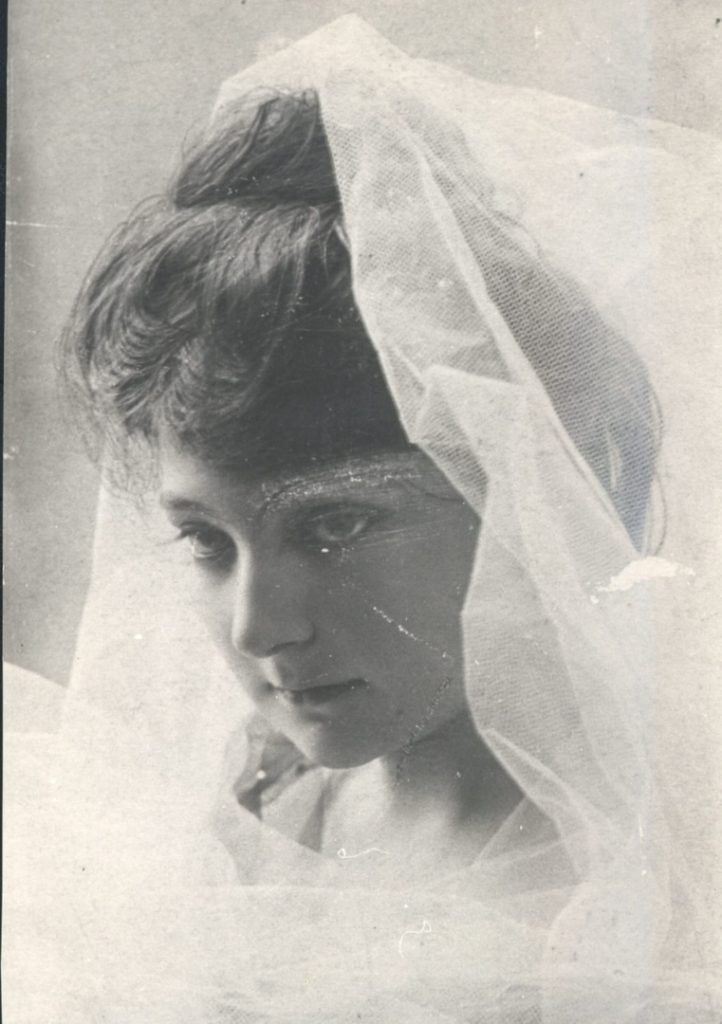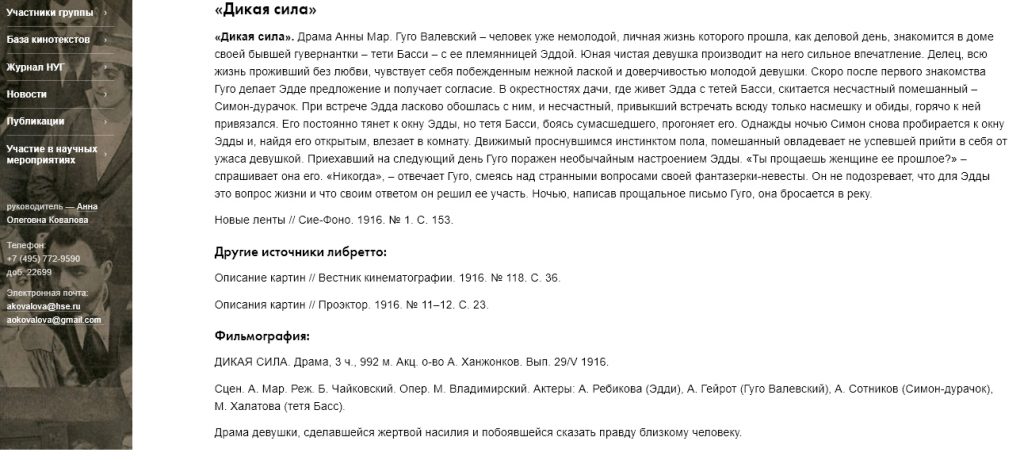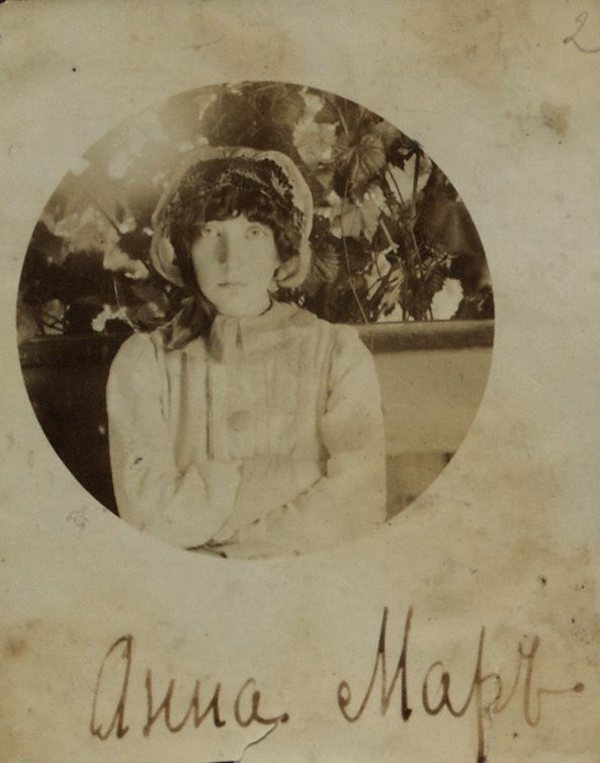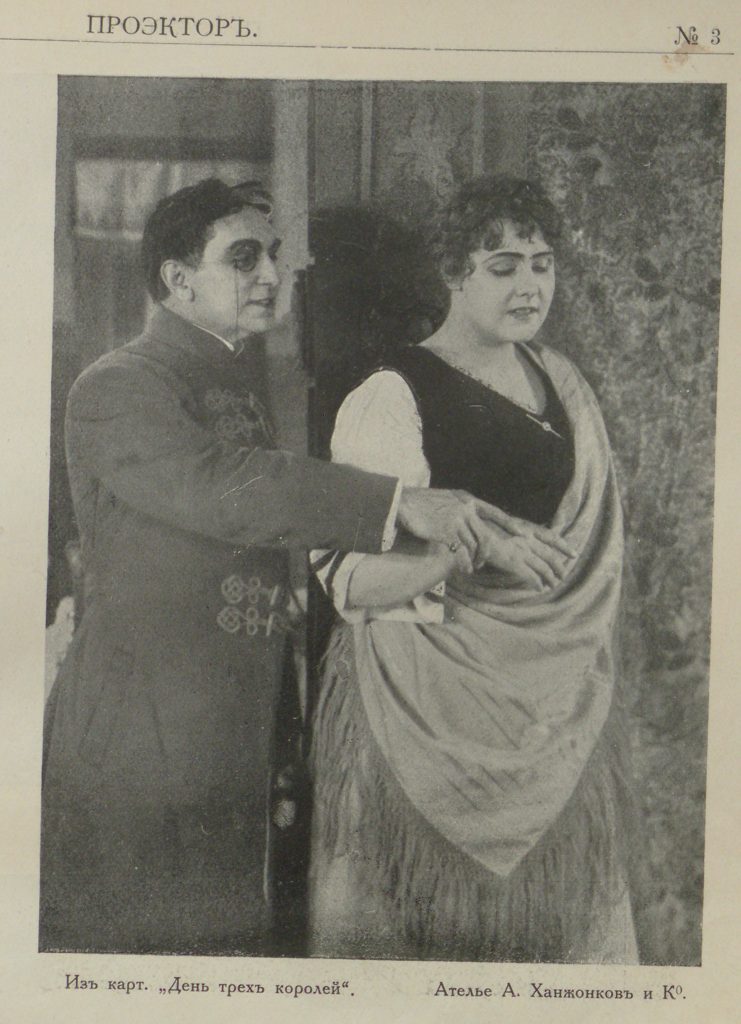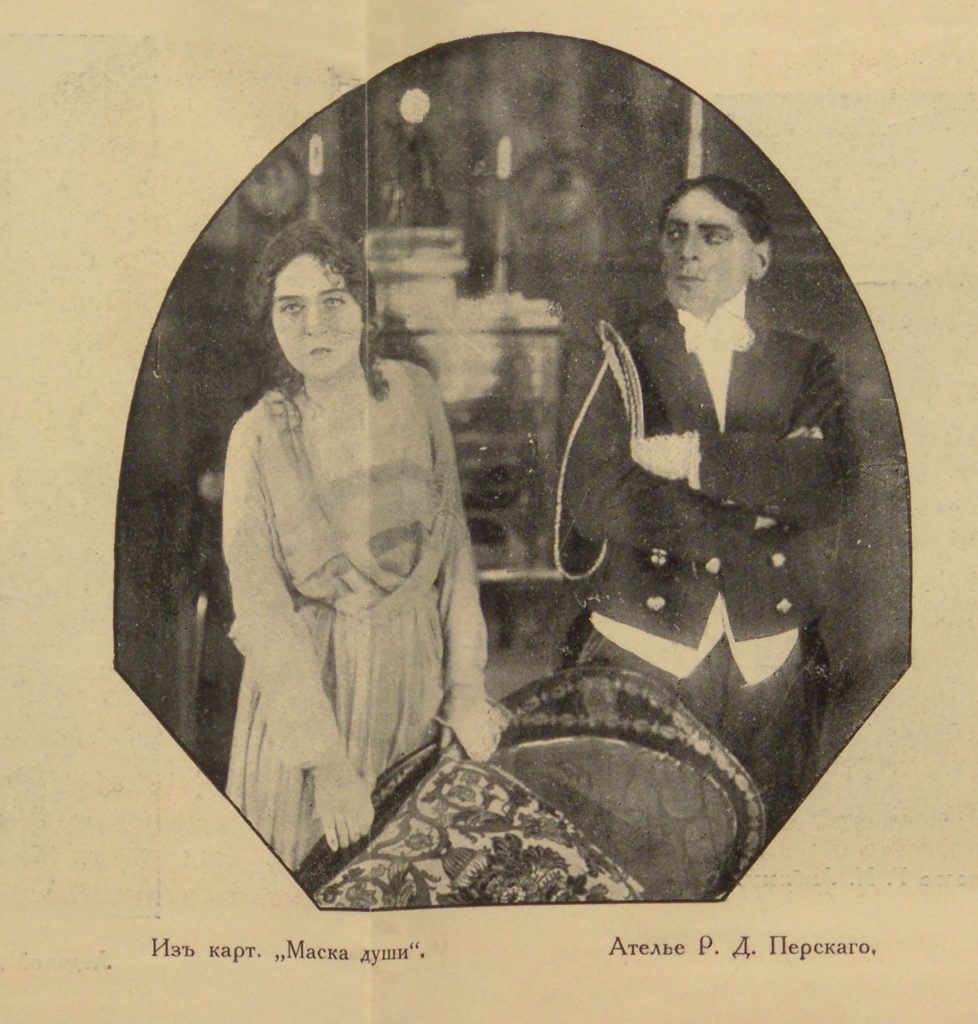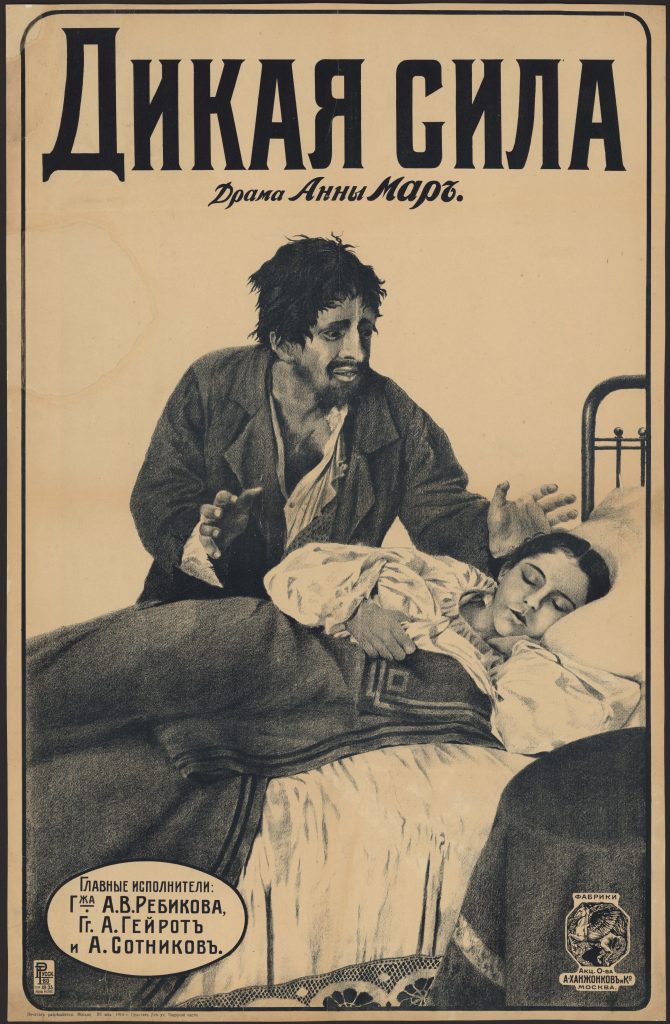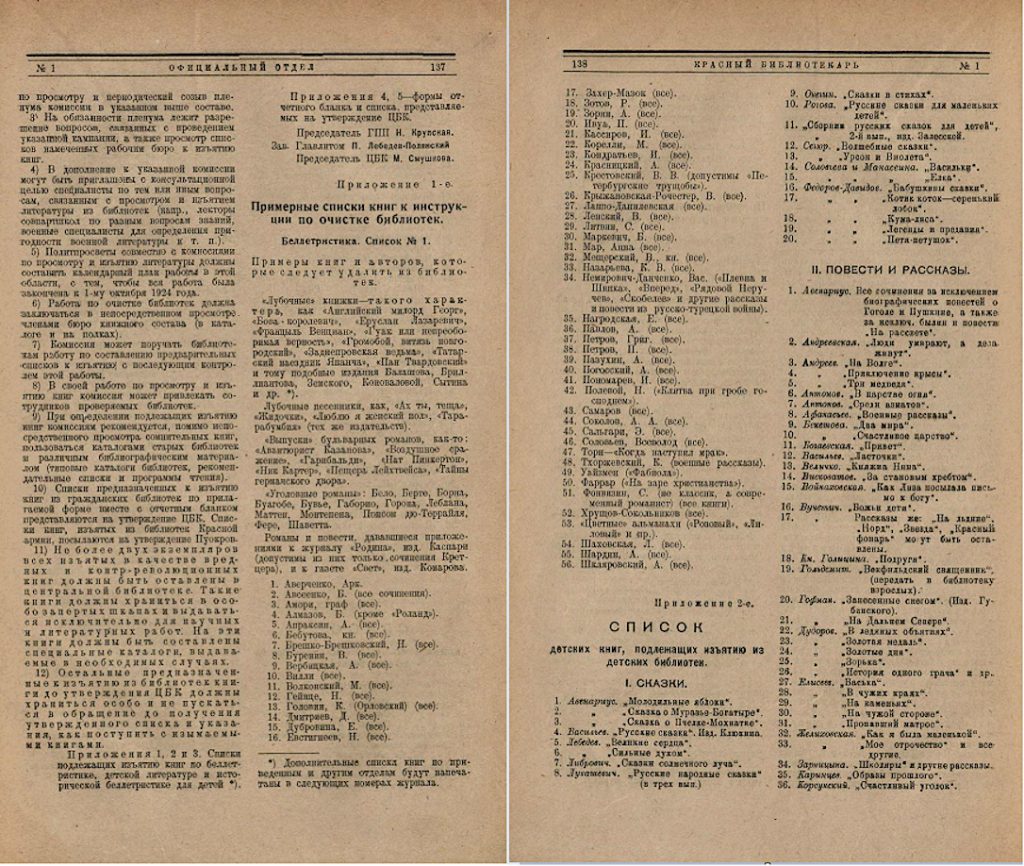According to the list of films in Veniamin Vishnevskii’s 1945 catalogue of early Russian feature films, the first Russian female screenwriters started working in 1910. Based on my analysis of the catalogue, approximately 7% of feature film production in imperial Russia was written by thirty-seven different female authors. Anna Mar, a famous Russian novelist who began her screenwriting career in 1914 for film producer Alexandr Khanzhonkov, was the second most productive of these female screenwriters. (The first one was Olga Blazhevich, a translator who wrote fifteen screenplays.) From 1914 to 1917, Mar wrote, according to Vishnevskii’s catalogue, eleven scripts for different Russian film studios: Lyulya Bek (1914), Stupefaction/Durman (1915), Three Kings’ Day/Den’ trekh koroley (1916), Mask of a Soul/Maska dushi (1916), Light-Blue Irises/Golubye irisy (1916), Storm of Love/Smerch l’ubovny (1916), Wild Force/Dikaya sila (1916), Aphrodite’s Taunt/Nasmeshka Afrodity (1916), Dominator/Vlastelin (1917), Heart Thrown to Wolves/Serdtse broshennoe volkam (1917), and Saving the Neighbor/Spasenie blizhnego (1917). In 1918, after Mar’s death, her last films, Bewitched Circle/Zakoldovannyi krug (1918) and Jellyfish’s Smile/Ulybka meduzy (1918), were released.
Unfortunately, much of Mar’s film work is lost; only fragments of two films, Lyulya Bek and Wild Force, are preserved at Gosfilmofond. Moreover, all of her manuscripts are lost. Some of her letters to literary critics are preserved in the Russian State Archive of Literature and Arts (RGALI), but, in them, Mar makes no mention of her film career. Fortunately, however, some information about her film work can still be found today. Two of her thirteen scripts, Stupefaction and Storm of Love, were published in a pre-revolutionary journal called Pegas (Mar, “Durman” 7-22; Mar, “Smerch l’ubonyi” 3-24). There are also lists of intertitles from some of Mar’s films in the archive of the Gerasimov Institute of Cinematography (VGIK). Brief descriptions of film plots (librettos), including nine librettos for Mar’s films, were published in the pre-revolutionary press and are digitally available on the Early Russian Film Prose project website. Although librettos, used for film promotion in the press, were rarely written by the screenwriters themselves, these materials give us vital access to Mar’s lost work. A great deal of information on the screenwriter’s output is still missing, however. For example, while we have the credit information for her film Jellyfish’s Smile, the plot remains unknown.
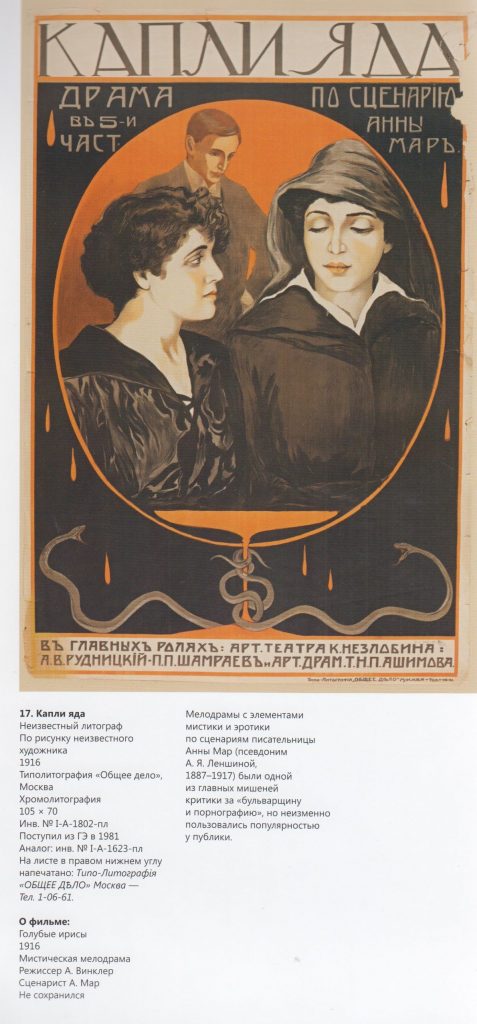
Film poster for Light-Blue Irises (1916) in The Silent Film Poster in the State Museum of the History of Saint Petersburg Collection 1914-1919 (2018).
Before Mar became one of the most well-known Russian screenwriters in the mid-1910s, she was a recognized writer. Born Anna Brovar in Saint Petersburg, she ran away from her parents’ home at the age of fifteen and got married in the city of Kharkov in the south of the Russian Empire (now Ukraine) (Reitblat 514-15). In Kharkov, she worked as an obituary writer for the newspaper Southern Edge/Yuzhnyi krai where her pseudonym “Anna Mar” appeared for the first time. In 1906, Mar published her first collection of short stories, or so-called “cartes postales,” entitled Miniatures/Miniat’ury.
In 1910, Mar began to write short stories for various journals and newspapers based in Moscow and Saint Petersburg. In 1912, she moved to Moscow where her short story, The Impossible/Nevozmozhnoe, was published. The story, about a married woman’s love for a Catholic priest, was highly praised by literary critics and has resulted in the widespread belief that Mar was in love with a monk herself. From then on, critics tended to read Mar’s literary texts as autobiographical. For example, an unnamed reviewer in Moscow Newspaper/Moskovskaya gazeta wrote: “In the short story, the undeniable writer’s talent was revealed […] there is the truth and a vital, perhaps even subjectively experienced, private drama” (Moscow Newspaper). Even today, some scholars suggest that “real feelings became a base for Anna Mar’s esthetic self-expression” (Gracheva 60).
The theme of religion was also central in Mar’s next three short stories, God/Bog, Unlit Icon-lamps/Lampady nezzazhennye, and The Passing By/Idushhie mimo, all published in 1913. Her next publication, the novel I Have Sinned Only for You/Tebe edinomy sogreshila (1914), which, like The Impossible was about a woman’s love for a priest, was seen as further evidence of Mar’s private affairs. Therefore, the private love life of this young Russian writer was already in the limelight during the first half of the 1910s.
In the mid-1910s, Russian film producers, following the example of foreign film companies, invited famous poets and authors to write screenplays for them. For example, Alexandr Khanzhonkov signed contracts with writers like Fyodor Sologub, Leonid Andreev, Alexandr Kuprin, Anna Mar, and others (Kushnirovich 136). The writers (for example, Kuprin) usually worked on screen adaptations of their literary texts. Mar was no exception, and her first film, Lyulya Bek, was a screen adaptation of her short story of the same name. All other film scripts written by Mar, however, were original stories for the screen.
The preserved fragment of Lyulya Bek is too short to tell us much about the film: in it, the café-chantant singer named Lyulya is holding a letter from her lover Vitold. The figure of the performing woman in early Russian cinema has been discussed by Rachel Morley in her book Performing Femininity: Woman as Performer in Early Russian Cinema (2017). As Morley points out, early Russian filmmakers were focused on the “typical gender roles of woman as performer and man as observer” (217), and female protagonists of early Russian films were often performers, like Lyulya. However, unlike other instances of this pattern, Lyulya seems conscious of her position. According to the digitized libretto, she leaves Vitold to give him a chance at happiness with another woman because, as Lyulya believes, her reputation and social status as a performer cannot let them be happy together. After she announces her decision to him, Vitold shoots himself at Lyulya’s performance in the café-chantant.
It seems that Mar shunned the typical pre-revolutionary Russian film plot described by film historian Neia Zorkaia in her monograph At the Turn of the Centuries: At the Origins of Mass Art in Russia in 1900-1910 (1976). According to Zorkaia, who followed folklorist Vladimir Propp’s ideas, the typical protagonist (both male and female) of early Russian cinema was always a victim or a seducer (245). Yet Mar’s characters are often more complicated than this simple binary.
For example, Jutta, the female protagonist of Three Kings’ Day is married but also has a lover. According to the libretto, on Three Kings’ Day (Polish Christmas), a second suitor—a count—promises to take Jutta to Paris. In order to unite with this new, second lover, she sets her husband and her first lover against each other and they both die in a shootout. Thus, she behaves like a seductress in a typical early Russian film plot. However, feeling guilty, Jutta soon reveals her involvement in the crime and the disappointed count leaves her. In an anonymous review, one critic drew attention to the final moments of the film when Jutta is suffering: “When the corpse of her husband is brought into a room full of guests, the heroine, addressing the count, immediately asks him to take her away…This action is not in the spirit of a sly, clever and careful woman” (“Den’ trekh korolei”). Jutta is no longer the seducer and transforms into the victim. This is likely why the critic, who was used to the typical binary in the film plots that Zorkaia described, was not satisfied with the final act of the film.
Additionally, in some of the films written by Mar, a woman is often a victim and a seducer at the same time. In Stupefaction, teenager Fanny dreams of becoming a model like her older sister Clara. She soon seduces the artist Mayevsky, who is also Clara’s lover. Learning the truth about her sister and Mayevsky, Clara throws herself out of the window, killing herself because she could not protect Fanny from working as a painter’s model (Mar, “Stupefaction” 7-22). From Clara’s point of view, the seductress Fanny is also the victim of Mayevsky. In Mask of a Soul, the main character, Irena Rembovskaya, is engaged to a count but is intrigued by the wealthy owner of an antique store, an Italian named Cesare Scabbi. She goes to visit and to seduce Cesare, but accidentally kills him “during lovemaking” (“Novye lenty”). She soon regrets betraying the count and punishes herself by committing suicide, blurring the line between seducer and sufferer.
This is not to say that Mar’s films always complicated the victim/seducer binary. Wild Force seems to follow the typical Russian film plot. As Zorkaia noted, if there is a female protagonist, she is likely to repeat the life of Liza, the character of Nikolay Karamzin’s short story Poor Liza/Bednaya Liza (1792) who drowns herself after her lover abandons her (Zorkaia 245). In Mar’s film, Edda likewise ends up committing suicide after a homeless man breaks into her bedroom and rapes her. The preserved fragment of the film represents the scene of Edda’s suicide. In it, she is standing on a cliff, hesitating, looking back and forth. The landscape plays an important role in this scene; Edda looks small and helpless among the thick trees and against the fast-flowing river in the background. In this film, the woman faces both the brutality of humanity and the power of nature. A critic in Vestnik kinematografii praised the story, seeing Edda as an unconventional character for Mar: “The script […] is not one of the most vivid screenplays written by Anna Mar but at the same time the theme and its representation on the screen are unconventional for the writer who often repeats her templates in her best works for the screen” (“Dikaya sila”). Thus, what was seen as rare in Mar’s work was an acceptance of traditional, static victim/seducer characterizations. By following these conventions, Mar ultimately satisfied the critics.
Mar’s focus, in both her literary prose and her screenplays, was ultimately on the female condition and the challenges that women faced in society. This interest in women’s everyday experiences in Russia stemmed from a particular journalistic endeavor that put her in direct communication with them. From 1914 until her death, under the pseudonym “La princesse Lointaine,” Mar wrote short articles on women’s everyday life and answered readers’ letters in a column called “Private Talks” [“Intimnye besedy”] in the Journal for Women. Women wrote to La princesse Lointaine about their private lives, relationships, marriages, and loves. As she once noted, her column, “supported women who were left alone, who were afraid to keep a child, who did not know another way to get financial independence but prostitution and those who were about to commit suicide” (“Intimnye besedy” [1917]). Mar ultimately took part in the editing of seventy-four issues of the Journal for Women and answered hundreds of letters. Not only did this experience give Mar access to different women’s perspectives over the course of her career, but she also seemed to consider these readers an important audience for her work. Addressing female readers of the Journal for Women, Mar claimed that, “All my stories and novels, from the first to the last, I dedicated only to you. […] Do you remember how often you wrote to me after reading my novels?” (“Intimnye besedy” [1914]).
Over the course of her film career, Mar wrote scripts for film studios like Akz. o-vo A. Khanzhonkov, T/d Perskii, T-vo Kinoiskusstvo, Argo, Biofilm, and Ekran. Looking at the film posters for many of her films, it is apparent that Mar was a recognizable entity in the film industry. Her name is often more noticeable than the actors’ names, and the critics often paid attention to her work even though it was more common to ignore the screenwriter altogether and comment on the director and the actors instead. Such attention to her work from the critics was likely due to her unconventional film plots and atypical female protagonists. In 1916, Mar also won the first competition for screenwriters in Russia with her script for Heart Thrown to Wolves (Korolevich 13). As Vladimir Korolevich noted, her win was unexpected because many popular and experienced male authors took part in this competition (13). Unfortunately, her winning script is lost and the plot of the film, which was released in 1917, can only be reconstructed thanks to a review of the film. According to the unnamed critic, the film involved, “an affair, exile from home, the rapprochement with a new lover, the murder of the previous lover, the suicide of the husband, regrets and horrors of the ‘bottom’ because of the return to the first lover” (Proektor).
In 1917, a few months after the release of her novel Woman on the Cross/Zhenschina na kreste, Mar poisoned herself in her rented apartment on Tverskaya Street in Moscow. She had been working on Woman on the Cross from 1914 until 1916 while she was writing screenplays and contributing to “Private Talks.” The controversial novel followed Alina Rushits, a rich twenty-eight-year-old woman who dreams of physical punishment at the hands of the book’s sadistic male character, fifty-four-year-old Heinrich Shemiot. The story covers their relationship and ends with the full and voluntary subordination of the woman to the man. The book was not well received, and the criticism of it affected Mar. In her obituary, Mar’s close friend Lidia Pisarzhevskaya wrote:
A criticism? It contributed to the sea of bitterness that had accumulated in Mar’s wounded, humble heart. ‘‘Woman On The Cross! I don’t know,” she said to me this summer with her voice broken with desperation. And with a nervous gesture, she threw out a whole pile of newspaper clippings, ‘‘Forty-nine negative reviews! Too much for one woman!” (Pisarzhevskaya)
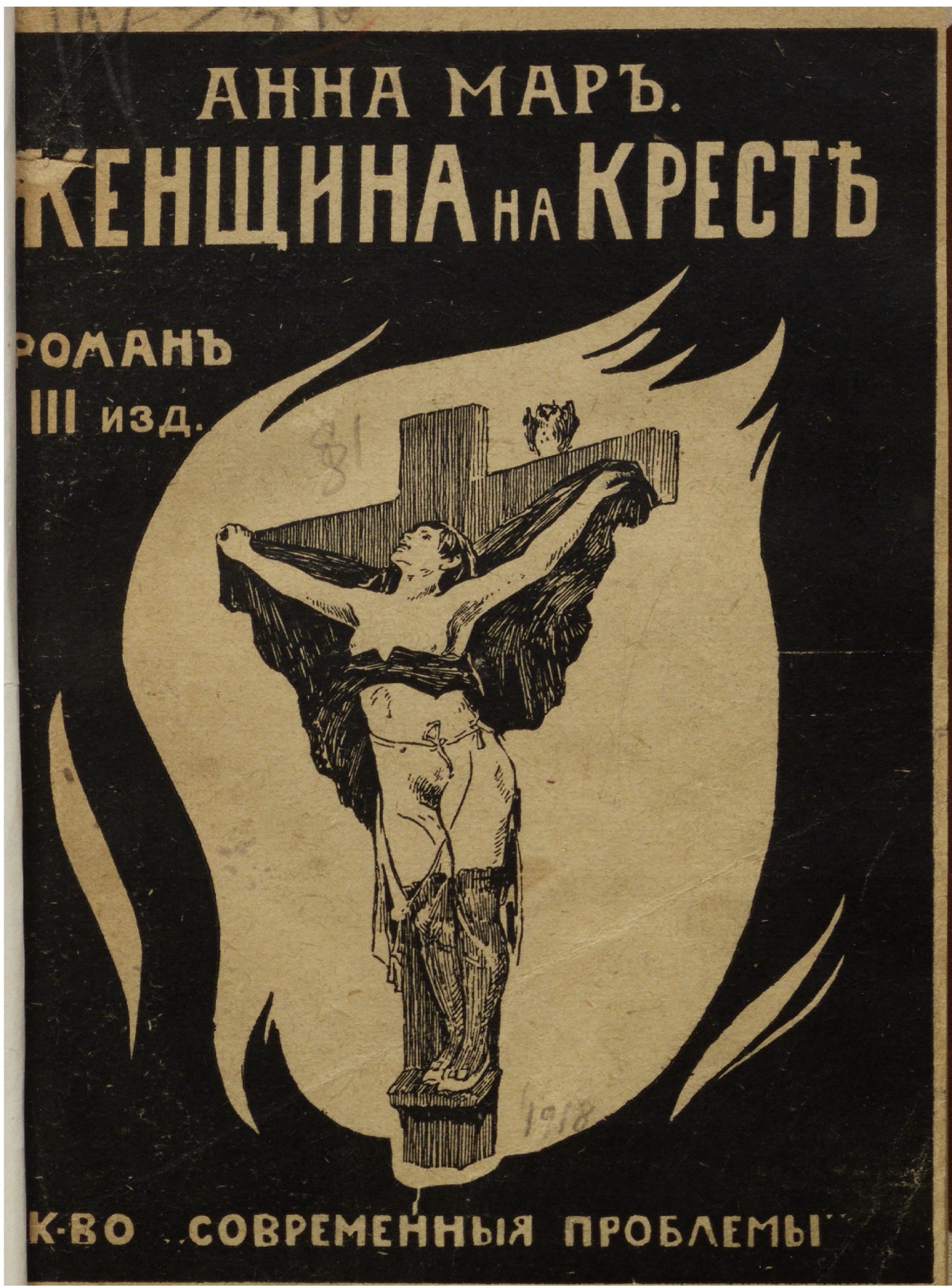
The cover of the third edition of Anna Mar’s book Woman on the Cross (published in 1918). Private Collection.
Woman on the Cross was sold out within two weeks of its publication and was adapted for the screen that same year but without the permission of Mar, who was still alive at the time. Directed by Viacheslav Viskovskii, the film was released with the title Offended Venera/Oskorblyonnaya Venera. Viskovskii changed the main premise of Mar’s story, and had the female character kill the sadistic male protagonist in the end. Unhappy, Mar wrote to the anonymous screenwriter of Offended Venera: “I express to Mr. Anonymous not only my timid censure, I also dare remind him that I still have four books not stolen yet” (Mar, “Pis’mo v redaktsiyu” 126).
After Mar’s suicide, her legacy began to fade. In 1924, the process of collectivization of Russian libraries led to the exclusion of Mar’s short stories and novels from libraries. The first lists of authors, whose books were supposed to be banned, were published in a journal called Red Librarian/Krasnyi bibliotekar.’ Mar’s name, with the indication “(all)” next to it, was included in the first part of the list entitled “Mass Literature” (“Primernye spiski” 138). Thus, Mar’s literary texts were difficult to access for Soviet readers. It was only in the 1990s that Woman on the Cross and some of Mar’s short stories were republished. Fortunately, there appears to be growing scholarly interest today in Mar’s literary prose, as well as in the work of her coevals, the other female writers who were also actively forgotten during the Soviet era. The newest collection of Mar’s literary texts, Woman on the Cross, was released by the publishing initiative “Common place” in Moscow in 2020. At the same time, the lack of filmic materials and the inaccessibility of sources make it difficult to reconstruct Mar’s screenwriting career, as well as the history of pre-revolutionary Russian cinema more broadly, which still seems more attractive to archivists rather than to film scholars. Therefore, Mar’s work for the screen remains under-explored today even though she was one of the most productive female screenwriters of her period.
The author wishes to thank Maria Nesternko and Maria Mikhaylova for the portraits of Anna Mar; Anna Kovalova for her advice and support; the archivists at VGIK for access to the preserved intertitles; and the archivists at Gosfilmofond for the opportunity to see the fragments of Mar’s films.

